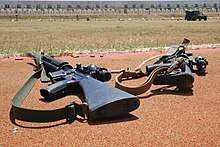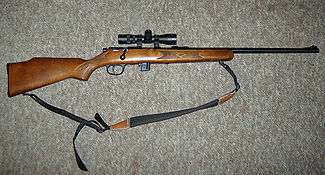Sling (firearms)
In the context of firearms, a sling is a type of strap or harness designed to allow a shooter to conveniently carry a firearm (usually a long gun such as a rifle, carbine, shotgun, or submachine gun) on their body, and/or to aid in greater hit probability by allowing the firearm to be better braced and stabilized during aiming. Various types of slings offer their own advantages and disadvantages, and can generally be divided into several categories.

Types of setup
- Simple/traditional sling (two-point)
- The oldest and most familiar design, this sling design has two connection points that attach to the front and rear of the weapon, and allows the shooter to carry the weapon over their back, with the sling draped across the torso, around the neck or over one shoulder. Some two-point slings, if properly made, can act as a shooting aid.[1][2]
- Ching/CW sling
- This type of sling is a component of the Scout Rifle concept, and serves not just as a carrying strap, but as an aid to greater hit probability by helping the shooter aim steadily.[3]
- Two-point quick-adjust sling
- Similar to a two-point simple sling, but with the capability to quickly adjust the length of the sling with a pull-tab.
- Three-point sling
- The advantages of the three-point sling are that it functions more like a harness and is therefore strapped to the shooter. This allows the shooter to release the weapon to use their hands for other tasks (such as transitioning to a sidearm) without fear of dropping it on the ground since it will remain hanging from the shooter and easily accessible when needed again.[4] The design of the three-point sling consists of a loop of material (usually cordura or similar) that loops around the torso, and two straps that go to the front and rear of the weapon. The shooter's body and the front and rear of the weapon are the three points that give this design its name.
- Single-point sling
- A specialized sling design that permits the shooter to transition to firing from the opposite shoulder. Like the three-point sling, the single-point sling permits the shooter to drop the weapon and let it hang downward while still attached to their body. This sling design is best suited for short-term tactical use. A single-point sling is only worn in one way, and cannot provide the same degree of long-term anti-fatigue weight support as other slings. The one great advantage of the single point design is that it is very easy to switch from shoulder to shoulder for weak side barricade shooting.[4] Negative attributes of the single-point sling include a tendency to make the rifle dangle and hang off the shooter in an inconvenient fashion; it can interfere with the shooter's movement and hang up on the shooter's gear.
 Traditional two-point sling on an M16A1 rifle.
Traditional two-point sling on an M16A1 rifle. Modern quick-adjust two-point sling on an M16A4 rifle.
Modern quick-adjust two-point sling on an M16A4 rifle.- Three-point sling on a Springfield Armory M1A SOCOM 16 rifle.
 Three-point sling on a Norwegian produced AG-3 rifle.
Three-point sling on a Norwegian produced AG-3 rifle.
Mounting standards
There are several mounting standards for attaching a sling to a rifle, of which some well known are sling swivel studs, QD/ Flush Cup or snap hooks (i.e. HK-type snap hook or Magpul Paraclip).
Sling mounts also come in different widths for different webbings. The webbing on American slings are typically 1, 11⁄4 or 11⁄2 inch (25.4, 31.75 or 38.1 mm) wide, while European slings typically are 20 or 30 mm (0.79 or 1.18 in) wide.
 A sling attached to a Marlin 25N rifle by using swivel studs screwed into the wood stock, one near the butt of the rifle and the other attached to the forearm.
A sling attached to a Marlin 25N rifle by using swivel studs screwed into the wood stock, one near the butt of the rifle and the other attached to the forearm.
As a shooting aid
A variation of the single point sling is used in precision target rifle shooting from the prone position. The sling is not intended as a carrying aid, but is used to steady the rifle. For a right-handed shooter, the sling attaches to the top of the left arm, and clips onto the forend of the rifle. The left arm is wrapped under the sling. The sling with upper and lower arm form three sides of a triangle that provide a steady support for the rifle.
Carrying harness
A carrying harness usually refers to a type of sling made primarily for carrying the rifle, and not doubling as a shooting support. For example in biathlon, the carrying harness is often a separate item from the shooting sling, with both being attached to the biathlon rifle.[5][6] The carrying harness is designed to let the biathlete carry the rifle with minimal hindrance, and in such a way increase performance in the ski track. Special carrying harnesses have also been designed for anti-tank rifles,[7] since such rifles often are too heavy for carrying with a normal rifle sling.
References
- Harllee, William Curry (1912). U. S. Marine Corps Score Book: a Rifleman's Instructor. International Printing Company. pp. 22–30. ISBN 978-1-144-42930-8.
- Van Zwoll, Wayne (2006). Hunter's Guide to Long-Range Shooting. Stackpole Books. pp. 398–399. ISBN 978-0-8117-3314-4.
- Petzal, David (2004). "Sling Shot This simple strap can be a hunter's best friend or worst enemy". Field and Stream. Field and Stream. 109 (11): 61.
- Sweeney, Patrick (2005). The Gun Digest Book of the AR 15. Iola, WI: Gun Digest Books. p. 145. ISBN 978-0-87349-947-7.
- Maverick Biathlon - Harness How To Guide
- YouTube - Biathlon Carrying Harness
- "The Anti-Tank Rifle" by Steven J. Zaloga